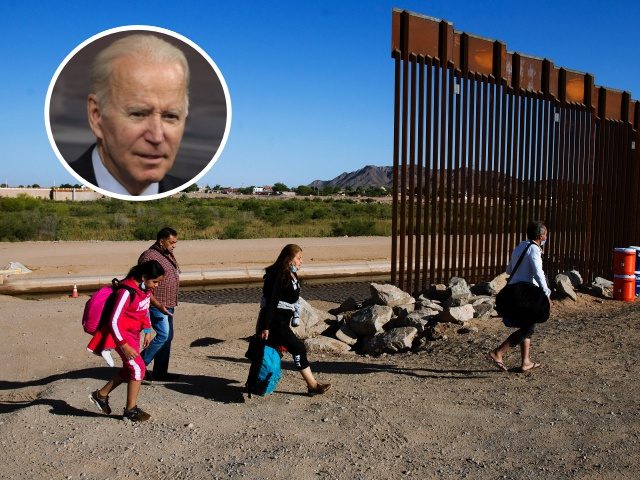A YouGov poll shows Americans overwhelmingly oppose the Democrats’ proposal to curb price inflation by adding more cheap-labor migrant workers to the U.S. economy.
The February 12-15 poll asked 1,500 citizens: “Do you think the following measures intended to reduce inflation are a good idea or a bad idea? …. Increase immigration to reduce worker shortages?”
Just 27 percent of registered voters agreed that importing workers to reduce inflation is a good idea, including 45 percent of President Joe Biden’s 2020 voters.
Fifty percent of registered voters said it was a “bad idea,” including 83 percent of President Donald Trump’s 2020 voters.
Independents split 23 percent good idea, 49 percent bad idea.
Twenty-eight percent said they were “not sure.” The group likely does not care about the issue, and likely would not change their votes if politicians endorse or reject the plan.
Since December, Democrats and business lobbies have been trying to revive the Build Back Better immigration expansions by selling immigration as an inflation fix.
The Democrats’ migration-for-inflation plan would help wealthy people who have a lot of cash and stock wealth, and so would hurt poor people who rely on their wages.
The bad poll numbers, however, are pushing Democrats away from the migration-beats-inflation plan. Under the headline, “Senate Dems ditching BBB as inflation fix,” Axios reported on February 17:
“Well, there is no Build Back Better,” Sen. Catherine Cortez Masto (D-Nev.) told Axios. She said negotiations to lower prescription drug costs may hold the key to offsetting inflation.
Pro-migration business lobbies and Democrats have been pushing the migration-for-inflation plan for months.
“As the United States continues to experience historic labor shortages contributing to inflation and driving up costs for families, FWD.us analysis below shows that immigration relief could help address these shortages and curb inflationary trends,” said a December 12 report by FWD.us, an investor-funded pro-migration group.
“If we can alleviate the worker shortage [with migration], it might be the fastest thing to do to impact inflation,” said Suzanne Clark, the CEO of the Chamber of Commerce, said mid-January. “We need more workers. We should welcome people who want to come here, go to school and stay … we do believe it would be anti-inflationary.”
The Democrats’ top advocate for amnesty and migration, Sen. Dick Durbin (D-IL), also backed the migration-for-inflation argument on December 2, according to a Bloomberg reporter: “Asked if immigration parole proposal in [the pending Build Back Better bill] would decrease inflation, Durbin says ‘Oh most certainly … If there are more workers filling those jobs, it’s deflationary.’”
But there is little evidence that rising wages are driving inflation. Instead, inflation is being caused as buyers compete for relatively scarce goods. Reuters.com reported on February 10:
Underlying inflation last month was driven by a 0.5% increase in rents, the largest rise since May 2001. The rental vacancy rate is the lowest since 1984. The core CPI was also boosted by strong gains in the prices for apparel, airline fares, household furnishings and operations as well as used cars and trucks.
Rising wages add little to inflation. “We find that the recent brisk surge in the propensity to search on the job has contributed to raising inflation by around 1 percentage point during most of 2021,” says a February report by the Federal Reserve bank of Chicago.
In fact, inflation might be worsened by the Biden administration’s loose migration rules. Prices were already rising in 2021 as the nation’s cheap-labor/low-tech housing industry built few new homes — and as roughly 2 million new migrants, legal and illegal, began to compete for housing against the roughly 4 million young Americans who entered the workforce in 2021.
In the YouGov poll, the strongest support for the cheap-labor plan came from liberals (49 percent), Biden voters (45 percent), college graduates (32 percent), and people who earn more than $100,000 (37 percent).
The strongest opposition came from people without college degrees (63 percent). people older than 65 (56 percent), Republicans (78 percent), conservatives (78 percent), and rural voters (53 percent).
Migration moves money, and since at least 1990, the federal government has tried to extract people from poor countries so they can serve U.S. investors as cheap workers, government-aided consumers, and high-density renters in the U.S. economy.
That economic strategy has no stopping point, and it is harmful to ordinary Americans because it cuts their career opportunities and their wages while it also raises their housing costs.
Extraction migration also curbs Americans’ productivity, shrinks their political clout, and widens the regional wealth gaps between the Democrats’ coastal states and the Republicans’ Heartland states.
The economic strategy also kills many migrants, separates families, and damages the economies of the home countries.
An economy built on extraction migration also radicalizes Americans’ democratic, compromise-promoting civic culture and allows wealthy elites to ignore despairing Americans at the bottom of society.
Unsurprisingly, a wide variety of little-publicized polls do show deep and broad opposition to labor migration and the inflow of temporary contract workers into jobs sought by young U.S. graduates.
The opposition is growing, anti-establishment, multiracial, cross-sex, non-racist, class-based, bipartisan, rational, persistent, and recognizes the solidarity that Americans owe to each other.

COMMENTS
Please let us know if you're having issues with commenting.